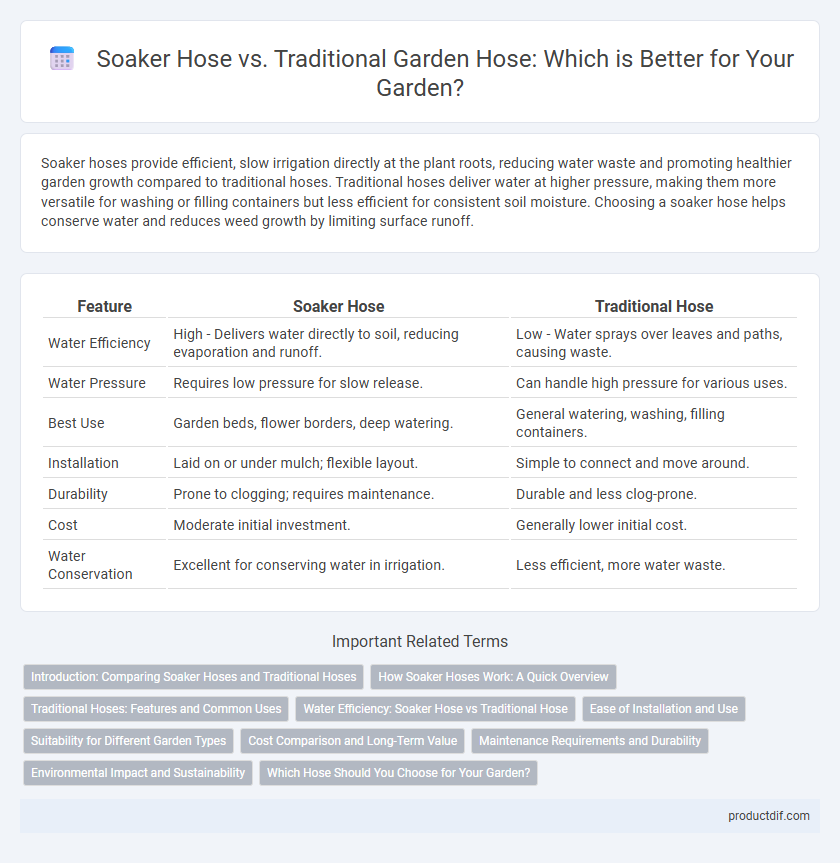Soaker hoses provide efficient, slow irrigation directly at the plant roots, reducing water waste and promoting healthier garden growth compared to traditional hoses. Traditional hoses deliver water at higher pressure, making them more versatile for washing or filling containers but less efficient for consistent soil moisture. Choosing a soaker hose helps conserve water and reduces weed growth by limiting surface runoff.
Table of Comparison
| Feature | Soaker Hose | Traditional Hose |
|---|---|---|
| Water Efficiency | High - Delivers water directly to soil, reducing evaporation and runoff. | Low - Water sprays over leaves and paths, causing waste. |
| Water Pressure | Requires low pressure for slow release. | Can handle high pressure for various uses. |
| Best Use | Garden beds, flower borders, deep watering. | General watering, washing, filling containers. |
| Installation | Laid on or under mulch; flexible layout. | Simple to connect and move around. |
| Durability | Prone to clogging; requires maintenance. | Durable and less clog-prone. |
| Cost | Moderate initial investment. | Generally lower initial cost. |
| Water Conservation | Excellent for conserving water in irrigation. | Less efficient, more water waste. |
Introduction: Comparing Soaker Hoses and Traditional Hoses
Soaker hoses deliver water directly to plant roots through porous materials, enhancing water efficiency and reducing runoff in garden irrigation. Traditional hoses provide versatile, high-pressure water flow suitable for various outdoor tasks but often result in uneven watering and higher water waste. Choosing between these hose types depends on specific garden needs, water conservation goals, and watering precision preferences.
How Soaker Hoses Work: A Quick Overview
Soaker hoses release water slowly and evenly through tiny pores along their length, providing deep soil irrigation that reduces water runoff and evaporation. Unlike traditional hoses that deliver water under pressure through a single stream or spray nozzle, soaker hoses allow water to seep directly into the ground around plant roots. This method conserves water and promotes healthier plant growth by maintaining consistent soil moisture levels.
Traditional Hoses: Features and Common Uses
Traditional hoses are typically made from durable materials like rubber or vinyl, offering flexibility and strength for various gardening tasks. They come in multiple diameters and lengths, suitable for watering plants, washing vehicles, and cleaning outdoor surfaces. Commonly equipped with adjustable nozzles, traditional hoses allow users to control water pressure and spray patterns effectively.
Water Efficiency: Soaker Hose vs Traditional Hose
Soaker hoses deliver water directly to the soil through tiny pores, significantly reducing evaporation and runoff compared to traditional hoses that spray water over foliage. This targeted watering method improves water efficiency by ensuring more moisture reaches plant roots, minimizing waste. Gardens using soaker hoses can save up to 50% more water than those relying on conventional hose watering techniques.
Ease of Installation and Use
Soaker hoses offer superior ease of installation due to their flexible design that can be laid directly on garden beds without additional connectors, unlike traditional hoses which often require multiple fittings and adjustments. Their porous material enables even water distribution with minimal manual intervention, reducing the need for frequent repositioning or monitoring. Traditional hoses demand more effort to maneuver around plants and often necessitate regular handling for watering control, making soaker hoses more user-friendly for efficient garden irrigation.
Suitability for Different Garden Types
Soaker hoses provide gentle, slow water delivery ideal for garden beds, flower borders, and vegetable patches, ensuring deep soil saturation without runoff or erosion. Traditional hoses offer versatile water supply suitable for lawns, larger garden areas, and tasks requiring high water pressure or mobility. Gardeners should select soaker hoses for targeted irrigation in densely planted or sensitive areas and traditional hoses for general watering and cleaning needs.
Cost Comparison and Long-Term Value
Soaker hoses typically cost less upfront than traditional hoses but offer greater water efficiency by delivering moisture directly to plant roots, reducing water waste and utility bills over time. Traditional hoses may require more frequent replacements due to wear and potential leaks, increasing long-term expenses compared to the durable, low-maintenance design of soaker hoses. Investing in a soaker hose provides better long-term value through enhanced irrigation efficiency and lower maintenance costs in garden supply applications.
Maintenance Requirements and Durability
Soaker hoses require less maintenance than traditional hoses due to their slow, even water release that prevents clogging and reduces wear. Traditional hoses often need frequent inspection for kinks, leaks, and damage caused by water pressure or sunlight exposure. Durability-wise, soaker hoses typically last longer in garden environments as they are designed to withstand soil contact and moisture without cracking, while traditional hoses may degrade faster under similar conditions.
Environmental Impact and Sustainability
Soaker hoses deliver water directly to plant roots, reducing runoff and evaporation, which conserves water and minimizes environmental impact compared to traditional hoses that often waste water through surface runoff. Made from flexible, porous materials, soaker hoses promote sustainable gardening by lowering water consumption and enhancing soil health. Traditional hoses, while versatile, tend to contribute to overwatering and increased water waste, making soaker hoses a more eco-friendly choice for sustainable garden irrigation.
Which Hose Should You Choose for Your Garden?
Soaker hoses deliver water directly to the soil, promoting deep root growth and reducing evaporation, making them ideal for garden beds and efficient watering. Traditional hoses offer versatility for washing, filling containers, and general garden maintenance but may waste water due to surface runoff. Choose a soaker hose for targeted irrigation and water conservation or a traditional hose for multi-purpose garden tasks requiring flexibility.
Soaker hose vs Traditional hose Infographic

 productdif.com
productdif.com